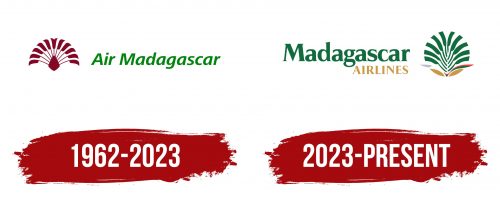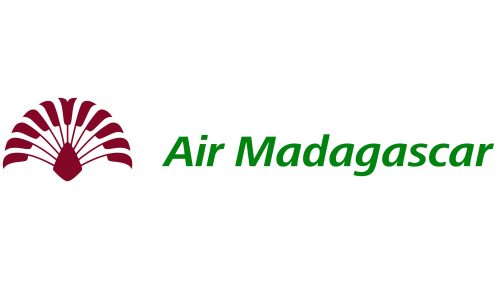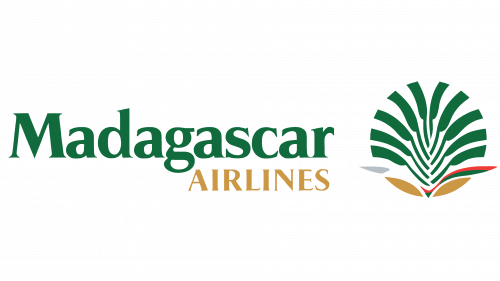The Air Madagascar logo conveys the company’s aspiration for uniqueness. It aims always to remain the island nation’s main national airline. This is demonstrated in its branding, which is infused with national spirit and emphasizes the brand’s distinctiveness. The emblem fuses local heritage with modern aspirations, making it appealing in the competitive airline market. It conveys the airline’s commitment to combining Madagascar’s rich culture with high air travel standards. The logo lets potential customers know that they are not just going on a flight but on an exciting journey through Madagascar, where diversity, richness, and authenticity reign supreme.
Air Madagascar: Brand overview
In the early 1960s, after gaining independence from France, Madagascar took a major step by establishing Air Madagascar. President Philibert Tsiranana signed the founding decree on June 25, 1962, helping connect the island nation internally and internationally.
The airline started with four Fokker F27 turboprop aircraft, each capable of carrying 40 passengers. The first flight took off on October 4, 1962, from Antananarivo to Toamasina, aiming to link Madagascar’s cities effectively.
By 1967, the airline was set to grow. It added larger Hawker Siddeley HS 748s and Ilyushin Il-18s to its fleet, enhancing domestic services and beginning international flights. During the early 1970s, Air Madagascar launched routes to African neighbors like Mauritius, Reunion, Kenya, Tanzania, and South Africa, supported by newer, faster Boeing 737-200 jets.
The period from the late 1970s to the 1980s was very successful. The airline added Boeing 747-200s and later 767-200s, starting direct flights to major European cities like Paris, Frankfurt, and Geneva. At its peak, the airline had up to 15 aircraft and expanded routes to the Middle East, Europe, and Asia.
However, the 1990s were challenging. Economic troubles, rising competition, and an aging fleet strained the airline. By the end of the decade, Air Madagascar had faced financial issues.
The 2000s didn’t bring much improvement. Despite restructuring efforts and management changes, the airline struggled. In 2008, the government nationalized Air Madagascar to stabilize it.
Air Madagascar operates a smaller fleet, including six ATR 72 turboprops for domestic routes and two Boeing 737-300s for international flights. The airline flies to several African locations, Turkey, and France.
CEO Thierry de Bailleul and Chairman Mami Rakotondraibe are leading the airline through difficult times. The government is looking for investors to help modernize the fleet and keep the airline as Madagascar’s aviation hub.
Meaning and History
What is Air Madagascar?
Air Madagascar, officially called Société Nationale Malgache de Transports Aériens S.A., is a major airline based in the capital city of Antananarivo. The airline links Madagascar with the rest of the world, enhancing the island nation’s accessibility internationally. Since its founding, Air Madagascar has expanded its network and now flies to many destinations across Africa, Asia, and Europe. This expansion has strengthened Madagascar’s role in global tourism and trade.
1962 – 2023
Air Madagascar’s logo is unique in that it features the heraldic tree of the island nation. This tree is set against a neutral white background and is fan-shaped. The tree is the endemic Ravinala palm, which resembles a large fan. The emblem shows eleven leaves on long stems colored dark maroon. Next to the tree (on the right) is the airline’s name in green. The font is cursive, with barely visible dots at the tops of the letters “a” and “d.” The first letter of each word is uppercase; the rest are lowercase.
Using the Ravinala palm tree in the logo emphasizes Madagascar’s unique biodiversity and adds authenticity to the airline’s branding. The dark maroon leaves contrast beautifully with the green letters, creating an eye-catching visual identity. The stylization of cursive writing, especially the pointed accents on the letters “a” and “g,” adds sophistication. The mixed use of color, form, and typography yields a balanced, eye-catching design that effectively communicates the essence of the airline’s brand.
2023 – today
The new Air Madagascar logo has retained its most important element: the Ravinala palm, which grows in the country and is its official symbol. The fan-shaped crown is set against a simple white background, making the emblem easily perceived. However, some changes have been made.
- The leaves are now longer, with their sharp tips removed and given a clear rectangular shape to convey the business nature of the airline and its connection to the island of Madagascar. Thus, the presence of the Ravinala palm in the logo highlights the brand’s authenticity.
- The number of leaves has been reduced to 10, with a beige calyx and a red border added, indicating a flower that will eventually bear rich fruit. This symbolism hints at the company’s vast potential and confident outlook toward expanding its routes.
- A silver triangular element has been introduced, representing an airplane flying over the country’s airspace, symbolizing Madagascar’s main airline confidently conquering the skies.
The name is now prominently displayed. The font style has drastically changed: wide and straight glyphs are used instead of thin and italic ones. The text is split into two contrasting levels: the first is large, and the second is small, adding internal energy to the logo. Sharp serifs are present throughout but are subtle enough to convey the company’s business nature without evoking a sense of danger.
The color contrast supports a dynamic feel: the top word is green, and the bottom word is gold. This palette is found in the national heraldry. For example, green is taken from the country’s coat of arms, which symbolizes wheat sprouts. The combination of large green letters with gold creates an appealing look, indicating an action’s beginning and final result: the sprouts have grown green and then ripened into a rich golden harvest. In other words, the airplane took off and landed successfully as scheduled.
The brand’s concept is effectively conveyed through classic typography, endemic plants, and national colors, indicating its connection to a specific country and characterizing it as the official airline.
The Air Madagascar emblem was changed due to the company’s rebranding. It is now called Madagascar Airlines, directly reflected in the new logo.
FAQ
Where is Air Madagascar?
Madagascar Airlines, known as Air Madagascar, is based in Antananarivo, the capital of Madagascar. Its main base is at Ivato International Airport in the same city. The airline connects Madagascar to many places worldwide, including Europe, Asia, Africa, and nearby Indian Ocean islands. These connections are important for boosting tourism and business in Madagascar.
As the country’s national airline, Madagascar Airlines represents Madagascar globally. Through its flights and services, it helps people learn about Madagascar’s unique culture and beauty. The airline supports travel and business and helps Madagascar maintain good relations with other countries.
What is the IATA code for Air Madagascar?
The IATA code for Air Madagascar, or Madagascar Airlines, is “MD.” This two-letter code helps the aviation and travel industry recognize airlines worldwide. It is used to book, ticket, and plan flights. Air Madagascar operates in Madagascar and belongs to the Africa & Middle East region. Additionally, the airline has a code “258” for other identification needs in industry databases.
Who owns Air Madagascar?
Air Madagascar, the national airline, is mostly owned by the Malagasy government, making it a government-run company. The airline has faced financial troubles and problems running smoothly.
Previously, plans were to sell Air Madagascar to private investors to help it make money and improve services. However, these efforts to sell the airline did not work out. Economic issues, the importance of controlling major transportation, and worries about whether private investors would see a good return on their investment made privatization difficult. Because selling the airline didn’t work, those plans were stopped. The government still owns Air Madagascar and continues to operate despite its financial troubles.






